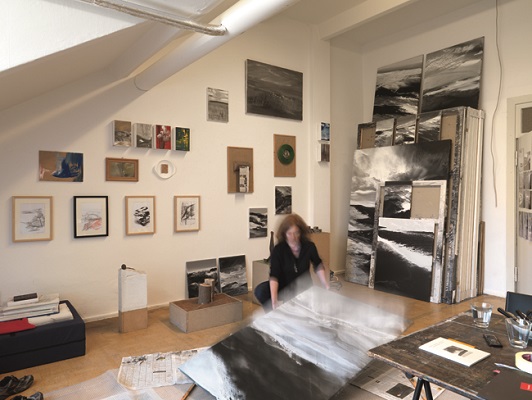Art & Exhibitions
German Artist Susanne Knaack Wishes to Dine With Richard Serra


Hélène Caron

The German-born artist Susanne Knaack, who studied under Georg Baselitz, has won admirers for her ‘controlled accident’ paintings, which transport the viewer into fantastic, tumultuous, and mysterious landscapes. In an interview in her Berlin studio, Knaack discusses some highlights of her career with artnet’s Hélène Caron.
Hélène Caron: Who and/or what are your artistic influences?
Susanne Knaack: At the moment, mostly my fellow artists, with whom I exchange a lot. These artists include H. H. Zwanzig, who explores the question of what constitutes an image, and who is a daily source of constructive debate. WillhelmW is a performance and object artist who is able to question me in a way that no one else can. Cédric Le Corf, in the way he treats his work with both energy and subtlety, fascinates me over and over again.
HC: What are you trying to communicate with your art?
SK: I’m not trying to communicate any message in particular that goes beyond the image as such. Some people would say that my message is simply: art for art.
HC: Describe your creative process. What kind of creative patterns, routines, or rituals do you have?
SK: It is important to have an open mind. The resulting image is always better when I do not try to have a concrete idea of what my intention is. Movement and gestures are very important aspects of my work. When I work on large-scale paintings, I hold the canvas from the back and swing it from side to side. I make the canvas vibrate by shaking it in order to put the paint in motion. I can control the flow of color that finds its way onto the surface of the canvas, in a very limited way. It is like playing with coincidences. The bigger the canvas, the more it eludes the process of rational control. The smaller the painting surface, the closer you come to a notation system and a methodical drawing process.
HC: Describe your studio or work space.
SK: The Nositiv Studio, which I founded together with the artist H. H. Zwanzig, is located in two sites. The ECC Berlin studio, in the Weißensee area outside the city center, is the largest gallery in Berlin. My studio is in a 1930s red brick building, on the third floor, with an open view. It’s a big space, which is perfect for my large-scale canvases. My second studio is situated in a basement in Berlin-Steglitz, in a building from the 1890s. It was a former shoemaker’s workshop. This studio is perfect for my small-scale works.
HC: When is your next exhibition? Why should we come?
SK: One exhibition is at Galerie Poll in Berlin, where Eva Poll and Nana Poll have organized an exhibition on the theme of landscape, featuring 17 artists. That exhibition is taking place February 8 through April 19, 2014. I am also looking forward to my exhibition with artworks by K.R.H Sonderborg (German, 1923–2008) at the Hamburger Galerie; Greta Verhuelsdonk is the curator. The opening will take place on April 5, 2014. In addition, I am participating in the Abstrakt Real exhibition at Galerie Kritiků in Prague, April 15 through May 11, 2014, with Franziska Rutishauser, Ludvik Feller (Czech, b.1929), and Jan Svoboda. And in September 2014, I will be having a solo exhibition in Buenos Aires curated by Pedro Roth at the Fundación Pasaje 865.
HC: Has the Internet dramatically changed the dynamic of your business?
SK: The Internet has greatly accelerated the work. Information transfer now takes place in a fraction of the time. 20 years ago, I had four to five exhibitions per year. Today I have 15 to 20.
HC: Would you recommend any particular type of training, courses, programs, or books to people interested in becoming artists?
SK: My recommendation is to practice. It’s not important when and where you practice, but it is always good to draw. I also think it’s important to take notes and to study. Nude drawing, for example, teaches you how to observe and concentrate. It brings you immediate results. Reading and writing are also a good exercise. These are the best ways to learn about yourself.
HC: What has been the highlight of your career so far?
SK: My participation in the exhibition Seestücke. Von Max Beckmann bis Gerhard Richter, which took place at the Hamburger Kunsthalle in 2007. I found it very enriching to see the incredible works from Martin Faass (today in Liebermann-Villa in Wannsee, Berlin) and Felix Krämer (today in Städel Museum in Frankfurt am Main).
HC: If you could have dinner with any three living artists, who would you choose?
SK: Georg Baselitz, because I still have a bone to pick with him; Gerhard Richter, because the two could argue about what art can and cannot be; and Richard Serra, who, in my opinion, is one of the greatest sculptors of all time.